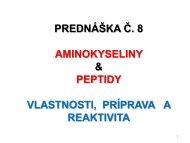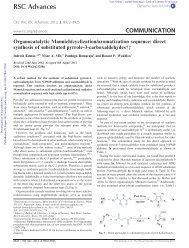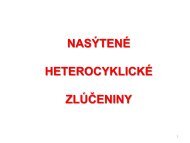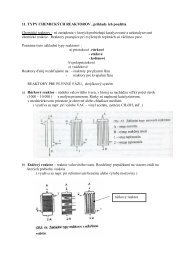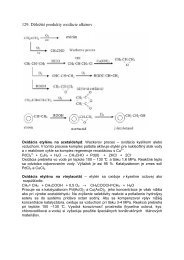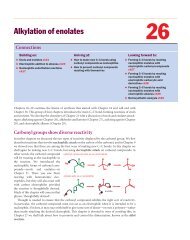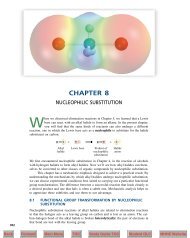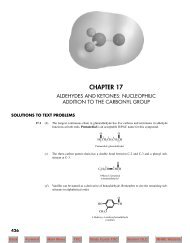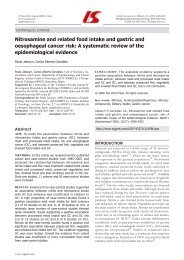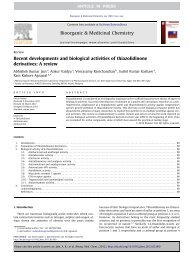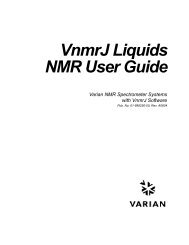You also want an ePaper? Increase the reach of your titles
YUMPU automatically turns print PDFs into web optimized ePapers that Google loves.
Scheme 62 Addition of Sodium Phenylacetylide to Tosyl Azide [184]<br />
Ph Na + −<br />
FOR PERSONAL USE ONLY<br />
458 Science of Synthesis <strong>13</strong>.<strong>13</strong> 1,2,3-<strong>Triazoles</strong><br />
1. TsN 3 (1 equiv)<br />
2. H 3O +<br />
9%<br />
1. TsN3 (excess)<br />
2. H3O +<br />
16%<br />
Ph<br />
170<br />
N<br />
N<br />
N<br />
Ts<br />
N3<br />
N<br />
N<br />
Ph<br />
N<br />
Ts<br />
4-Azido-5-phenyl-1-tosyl-1H-1,2,3-triazole (171); Typical Procedure: [184]<br />
A slurry of sodium phenylacetylide [prepared from PhC”CH (0.05 mol) and Na (0.05 mol)]<br />
in dry Et 2O (25 mL) was added slowly to a stirred soln of tosyl azide (19.7 g, 0.10 mol) in dry<br />
Et 2O (50 mL) at a rate which maintained the solvent at reflux. As the mixture was stirred<br />
for 24 h a brown solid separated (15.2 g, 58%), which corresponds to a sodium salt of an<br />
intermediate compound. Part of this compound (5.0 g) was treated with hot glacial AcOH<br />
(10 mL) and a light yellow solid was obtained upon cooling. Two recrystallizations (glacial<br />
AcOH) afforded pure triazole 171; yield: 0.52 g (16%); mp 170–1718C (dec).<br />
<strong>13</strong>.<strong>13</strong>.1.1.3.1.2 Addition of Azides to C=C Bonds<br />
The thermal cycloaddition of azides to alkenes is an important route to 1H-1,2,3-triazoles.<br />
Azides undergo addition to a wide range of angle strained, unstrained, and unactivated<br />
double bonds; to electron-rich double bonds such as enamines, enamides, enol ethers,<br />
and ketene acetals; and to alkenes bearing one or two electron-withdrawing groups. [7] In<br />
these reactions, 4,5-dihydro-1H-1,2,3-triazoles (D 2 -1,2,3-triazolines) are the addition products<br />
but they can be aromatized to the corresponding triazoles by elimination of suitable<br />
groups or by oxidation. In some cases the dihydrotriazoles aromatize spontaneously. Unlike<br />
the case of alkynes, the reaction of azides with alkenes is highly regioselective. Because<br />
of this, it may be convenient to prepare a triazole via the dihydrotriazole since at<br />
the end the separation of regioisomers is not needed.<br />
The synthesis of 1,2,3-triazoles via 1,3-dipolar cycloaddition of azides to alkenes requires<br />
patience. It may take weeks to months to obtain reasonable yields of the desired<br />
compound, especially if the C=C bond is not activated by electron-withdrawing or electron-donating<br />
substituents. Increasing the reaction temperature is not always a solution<br />
since it is restricted by the thermal lability of most dihydrotriazoles (they readily extrude<br />
N 2).<br />
<strong>13</strong>.<strong>13</strong>.1.1.3.1.2.1 Method 1:<br />
Addition of Sodium Azide to Activated Alkenes<br />
Sodium azide undergoes addition to alkenes with strongly electron-withdrawing substituents<br />
to give N-unsubstituted 1,2,3-triazoles in good yields (Scheme 63). The mechanism<br />
seems to involve the conjugate addition of the azide ion to the double bond, cyclization<br />
of the resulting anion, and aromatization. The synthesis of triazoles 173 by the reaction<br />
of sodium azide with Æ-nitroacrylic ester 172 (Y = CO 2Et) and Æ-nitro ketone 172 (Y = Bz)<br />
are examples of this method. [185] Other nitroalkenes are converted into 1,2,3-triazoles in<br />
the same way. [186] Similarly, triazole 175 is obtained, along with two minor dihydrotriazoles,<br />
from the reaction of diethyl (4-nitrobenzylidene)malonate (174) with sodium<br />
A. C. TomØ, Section <strong>13</strong>.<strong>13</strong>, Science of Synthesis, 2004 Georg Thieme Verlag KG<br />
171



